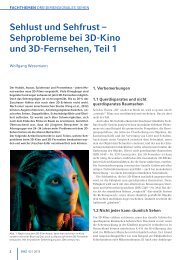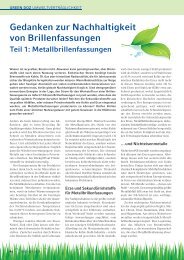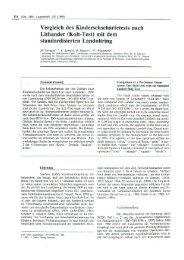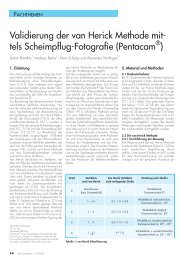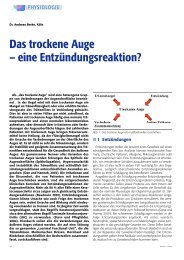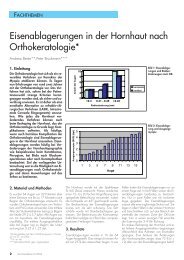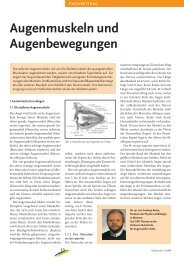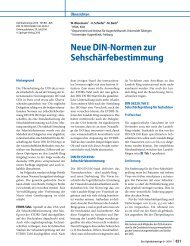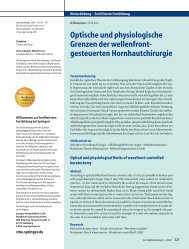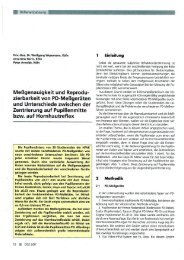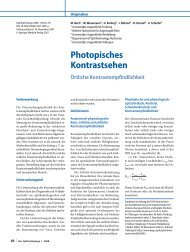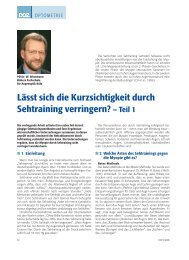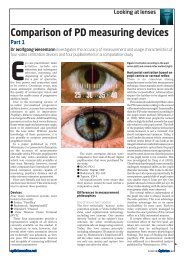Clinical evaluation of refraction using a handheld wavefront ...
Clinical evaluation of refraction using a handheld wavefront ...
Clinical evaluation of refraction using a handheld wavefront ...
Create successful ePaper yourself
Turn your PDF publications into a flip-book with our unique Google optimized e-Paper software.
HANDHELD WAVEFRONT AUTOREFRACTOR IN YOUNG AND ADULT PATIENTS<br />
Hartmann-Shack sensor. This sensor consists <strong>of</strong> a matrix <strong>of</strong><br />
tiny lenses arranged in many rows and columns. These lenses<br />
form many small light spots on the active surface <strong>of</strong> a chargedcouple-device<br />
(CCD) matrix camera.<br />
The refractive power is calculated from the positions <strong>of</strong><br />
the light spots according to the following general concept. If<br />
the patient has an emmetropic eye, parallel light rays leave the<br />
eye. These rays produce light spots on the CCD camera that<br />
are uniformly spaced. The distance between the light spots<br />
(Figure 1B) is typical in an emmetropic eye. In the case <strong>of</strong> pure<br />
hyperopia or myopia, the light spots are also uniformly<br />
spaced. The spot pattern, however, is expanded or contracted<br />
compared to that in emmetropia because the light rays that are<br />
reflected from the fundus leave the eye divergent or convergent.<br />
If the patient has an astigmatic ametropia, a light bundle<br />
that is no longer rotationally symmetric leaves the eye. In this<br />
case, the distance between the light spots on the CCD matrix<br />
varies in a way that depends on cylinder power and axis.<br />
Method <strong>of</strong> Comparative Measurements<br />
All autorefractor measurements without cycloplegia were<br />
taken immediately before the eyedrops were dispensed. After<br />
the waiting period, streak retinoscopy was performed under<br />
cycloplegia by 1 <strong>of</strong> us (T.S.) <strong>using</strong> <strong>handheld</strong> corrective lenses.<br />
The investigator was unaware <strong>of</strong> the results with the <strong>wavefront</strong><br />
autorefractor. The cycloplegic measurement with the Sure-<br />
Sight followed immediately. The “child mode” explained in<br />
the discussion section was not used.<br />
Criteria for the Accuracy <strong>of</strong> Measurement<br />
To obtain information about the accuracy <strong>of</strong> the <strong>wavefront</strong><br />
autorefractor, all readings were compared to the results<br />
<strong>of</strong> cycloplegic retinoscopy. All comparison criteria, with the<br />
exception <strong>of</strong> the J-vector analysis, were used in our earlier<br />
studies 1,2,5,11 and allow direct comparison <strong>of</strong> the <strong>wavefront</strong><br />
autorefractor described here with autorefractors tested in earlier<br />
years.<br />
The difference <strong>of</strong> the spherical equivalent (DSE) was calculated<br />
by<br />
DSE (S t 0.5 * C t) S c 0.5 * C c<br />
where S and C denote the spherical and the cylinder powers;<br />
the subscripts “t” (test) and “c” (comparison) denote the instrument<br />
under test (SureSight) and the comparison technique<br />
(cycloplegic retinoscopy). A negative DSE indicates a<br />
minus-overcorrection by the instrument under test.<br />
The difference <strong>of</strong> the cylindrical powers (DC) was calculated<br />
by<br />
DC Ct – Cc The weighted axes difference (DA) is a quality criterion<br />
based on the power-vector approach. It is evaluated by a mathematical<br />
expression in which the difference between the<br />
2 cylinder axes (test and comparison, measured in degrees) is<br />
weighted with the cylinder power measured with the comparison<br />
method.<br />
DA 2C c sin ( t – c)<br />
The formula makes it possible to compare axis values,<br />
even when the actual cylinder powers are different. C c is taken<br />
as a weighting factor since it is assumed to be more accurate<br />
then the cylinder power <strong>of</strong> the instrument under test. Geometrically,<br />
DA is the length <strong>of</strong> the difference vector between<br />
both methods given that the cylinder power found with the<br />
SureSight is equal to the cylinder power found with retinoscopy.<br />
The resulting number has the dimension “diopter.” A<br />
value <strong>of</strong> DA 0.5 D is equivalent to an axes difference <strong>of</strong><br />
14.5 degrees given a cylinder power <strong>of</strong> 1.0 D.<br />
The J-vector difference ( J ) is a measure <strong>of</strong> the difference<br />
between the cylindrical components. J describes the<br />
cylindrical difference in terms <strong>of</strong> 2 Jackson crossed cylinders<br />
with orientations <strong>of</strong> 0 degrees and 45 degrees, respectively. J<br />
is determined <strong>using</strong> the method <strong>of</strong> Raasch and coauthors. 15 At<br />
first, the J 0 and J 45 components <strong>of</strong> the (M, J 0, J 45) space<br />
described by Thibos and Horner 16 are calculated from the<br />
results <strong>of</strong> the SureSight and cycloplegic retinoscopy.<br />
J 0t –C t/2 cos 2 t<br />
J 45t –C t/2 sin 2 t<br />
and<br />
J 0c –C c/2 cos 2 c<br />
J 45c –C c/2 sin 2 c<br />
Then the J-vector difference ( J) between the cylindrical<br />
results <strong>of</strong> the test and the comparison instrument can be written<br />
as<br />
J J 0, J 45<br />
where J 0 and J 45 are defined by<br />
J 0 J 0t – J 0c<br />
J 45t J 45t – J 45c<br />
Our last quality criterion is the total cylindrical difference<br />
(TCD). It is the length <strong>of</strong> the vector J. The TCD is a summarizing<br />
measure for the cylindrical accuracy <strong>of</strong> the measurement.<br />
When the normal cylinder notation is used instead <strong>of</strong><br />
the Jackson crossed-cylinder notation, TCD is obtained by<br />
TCD C t 2 Cc 2 2CtC ccos 2 t c<br />
The terminology for this criterion differs in the literature.<br />
The term total cylindrical difference was introduced by 1 <strong>of</strong> us<br />
in 1987. 5 In our earlier papers, 2 the term combined cylindrical<br />
error was used. Wesemann and Dick 11 called the above expression<br />
the difference <strong>of</strong> the cylindrical corrections. In 2000, Raasch<br />
and coauthors 15 proposed the name astigmatic difference (see<br />
Appendix).<br />
J CATARACT REFRACT SURG—VOL 28, SEPTEMBER 2002 1657



